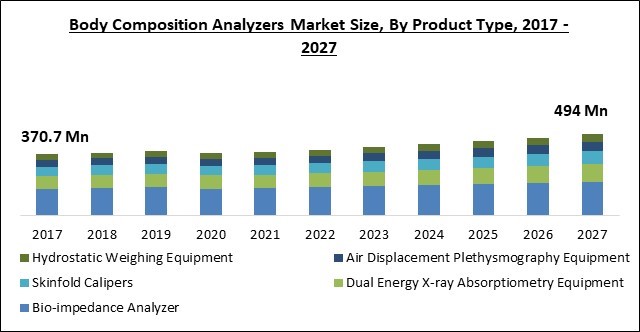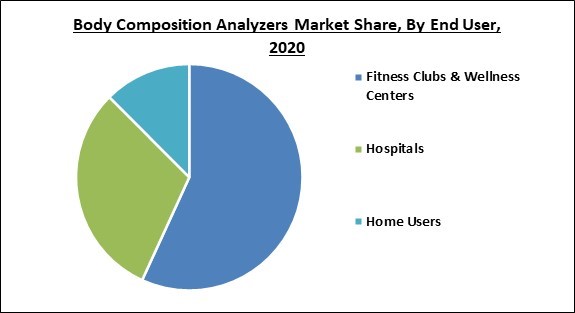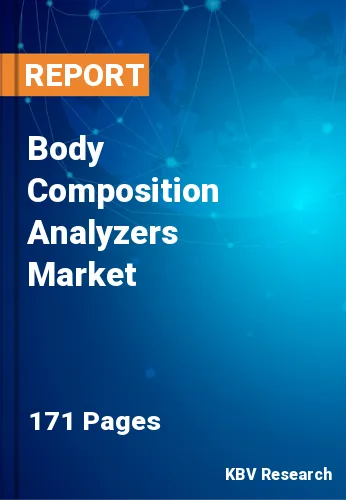The Global Body Composition Analyzers Market size is expected to reach $494 million by 2027, rising at a market growth of 4.2% CAGR during the forecast period.
The ratio of fat and fat-free mass in the body is called body composition. Obese patients and other fitness-conscious persons require body composition analysis to test and analyze their health and fitness levels. A body composition analyzer is a gadget that gives detailed data for customized health and fitness consultations. In addition, it is also utilized to construct a workout routine based on whether a person wants to reduce weight or gain muscle. Moreover, body composition can be measured in a variety of ways, each with its own set of benefits and drawbacks.
A way of examining the body's constituent constituents, such as fat, protein, minerals, and body water, is known as body composition. Moreover, a body composition analyzer (BCA) is a device that measures the makeup of various body components. The weight, body mass index (BMI), and weight percentages from fat, muscle, bone, and water are all accurately calculated with a body composition analyzer. Further, it also aids in the investigation of cumulative differences in body structure over a given length of time.
Obesity prevalence was very high in high-income and developed countries in 2018, according to data from the website worldobesity.org, with 42.8 percent in the United States, 31.3 percent in Australia, and 21.20 percent in Belgium.
Overweight and obesity rates in OECD countries have continued to rise to 58 percent of the adult population in 2019, according to the OECD Health Policy Studies. According to the survey, more than half of the population in 34 of the 36 OECD countries was overweight, and nearly one in four persons were projected to be obese. Moreover, overweight and linked disorders would shorten life expectancy by around three years throughout the OECD, EU28, and G20 countries between 2020 and 2050, according to the OECD.

In December 2019, the Coronavirus (COVID-19) was discovered in the Hubei province of Wuhan, China. The disease is caused by the severe acute respiratory syndrome coronavirus 2 (SARS-CoV-2) virus, which is spread between people. The disease quickly spread across the globe after its discovery in Wuhan. Fever, a dry cough, and weariness are among the mild symptoms. Severe symptoms, on the other hand, include breathing difficulties or shortness of breath, chest pain or pressure, and loss of speech or movement.
Furthermore, a number of countries throughout the world have enacted state-wide lockdowns in order to adhere to social distancing standards and prevent the virus from spreading. Because of lockdowns and stay-at-home orders, the COVID-19 pandemic is an unprecedented public health concern that is expected to have a detrimental influence on the body composition analyzers industry. Due to these circumstances, the demand for body composition analyzers for health monitoring is reduced during the pandemic.
Some of the key trends of the market are rising obesity, overweight, and aging populations around the world, as well as increased financing from governments and worldwide healthcare institutions for preventative healthcare. In addition, growing awareness of health and fitness, metabolic disorders, and heart disease would motivate people to keep a regular check on their health. In recent years, there has been an increase in government programs for a better living, various healthcare organizations such as the World Health Organization.
Dual Energy X-ray Absorptiometry Equipment (DEXA) is used to examine bone density in order to diagnose osteoporosis and assess the risk of fractures. DEXA is projected to become more commonly employed in hospitals as the prevalence of osteoporosis rises. Moreover, body composition analysis is becoming a standard aspect of patient treatment and wellness programs in many hospitals throughout the world.
There are many developing countries around the world that have low penetration of advanced healthcare devices. Moreover, such countries also face problems like stagnant economic growth and under-developed healthcare infrastructure. As a result, citizens living in such countries have low awareness about advanced and latest products which include body composition analyzers. Moreover, the high cost of these products prevents many people to use them, especially from developing and under-developed countries.

Based on the Product Type, the Body Composition Analyzers Market is segmented into Bio-impedance Analyzer, Dual Energy X-ray Absorptiometry Equipment, Skinfold Calipers, Air Displacement Plethysmography Equipment, and Hydrostatic Weighing Equipment. The Dual Energy X-ray Absorptiometry Equipment segment garnered a significant revenue share of the Body Composition Analyzers Market in 2020. It's frequently used to diagnose osteoporosis and determine a person's risk of getting osteoporotic fractures. DXA is a simple, quick, and painless procedure. It's also the most widely used and accepted method of detecting osteoporosis.
On the Basis of End-User, the Body Composition Analyzers Market is divided into Hospitals, Fitness Clubs & Wellness Centers, and Home Users. The Hospitals segment collected a significant revenue share of the Body Composition Analyzers Market in 2020. The rise in osteoporosis cases, increased adoption of body composition analyzers to measure nutritional status in patients, and increased health consciousness among the general public are all factors contributing to the segment's growth.
| Report Attribute | Details |
|---|---|
| Market size value in 2020 | USD 378.9 Million |
| Market size forecast in 2027 | USD 494 Million |
| Base Year | 2020 |
| Historical Period | 2017 to 2019 |
| Forecast Period | 2021 to 2027 |
| Revenue Growth Rate | CAGR of 4.2% from 2021 to 2027 |
| Number of Pages | 172 |
| Number of Tables | 280 |
| Report coverage | Market Trends, Revenue Estimation and Forecast, Segmentation Analysis, Regional and Country Breakdown, Companies Strategic Developments, Company Profiling |
| Segments covered | Product Type, End User, Region |
| Country scope | US, Canada, Mexico, Germany, UK, France, Russia, Spain, Italy, China, Japan, India, South Korea, Singapore, Malaysia, Brazil, Argentina, UAE, Saudi Arabia, South Africa, Nigeria |
| Growth Drivers |
|
| Restraints |
|
Based on the Region, the Body Composition Analyzers Market is analyzed across North America, Europe, APAC, and LAMEA. In 2020, North America emerged as the leading region in the overall the Body Composition Analyzers Market. This is attributed to the presence of a well-established healthcare infrastructure as well as ongoing R&D efforts in the regional market. Moreover, the market in North America is growing due to the development and adoption of new technologies as well as a high level of disposable income.
Free Valuable Insights: Global Body Composition Analyzers Market size to reach USD 494 Million by 2027
The market research report covers the analysis of key stake holders of the market. Key companies profiled in the report include General Electric (GE) Co. (GE Healthcare), Hologic, Inc., Omron Corporation, Bodystat Limited, COSMED Srl, InBody Co., Ltd., RJL Systems, Inc., SELVAS Healthcare (Selvas AI, Inc.), Tanita Corporation, and Seca GmbH & Co. Kg.
By Product Type
By End User
By Geography
The global body composition analyzers market size is expected to reach $494 million by 2027.
Growing awareness about health and fitness are driving the market in coming years, however, low penetration and product recall limited the growth of the market.
General Electric (GE) Co. (GE Healthcare), Hologic, Inc., Omron Corporation, Bodystat Limited, COSMED Srl, InBody Co., Ltd., RJL Systems, Inc., SELVAS Healthcare (Selvas AI, Inc.), Tanita Corporation, and Seca GmbH & Co. Kg.
The Bio-impedance Analyzer market acquired maximum revenue share in the Global Body Composition Analyzers Market by Product Type in 2020, achieving a market value of $203.3 million by 2027.
The Fitness Clubs & Wellness Centers market shows high growth rate of 3.8 % during the forecast period.
The North America market is generating high revenue in the Global Body Composition Analyzers Market by Region in 2020, and would continue to be a dominant market till 2027.
Our team of dedicated experts can provide you with attractive expansion opportunities for your business.

